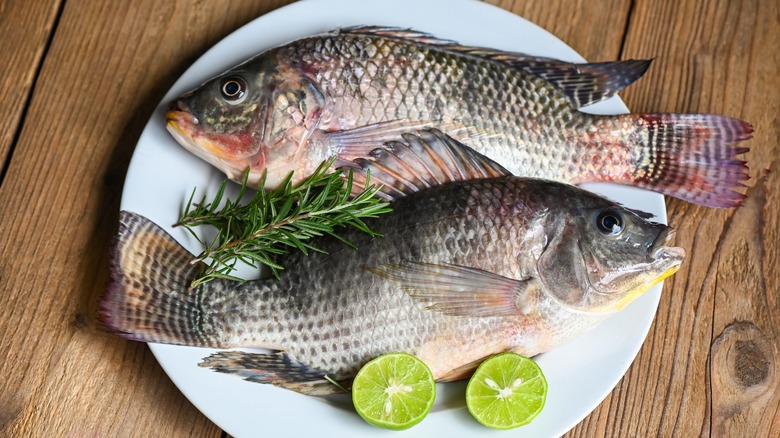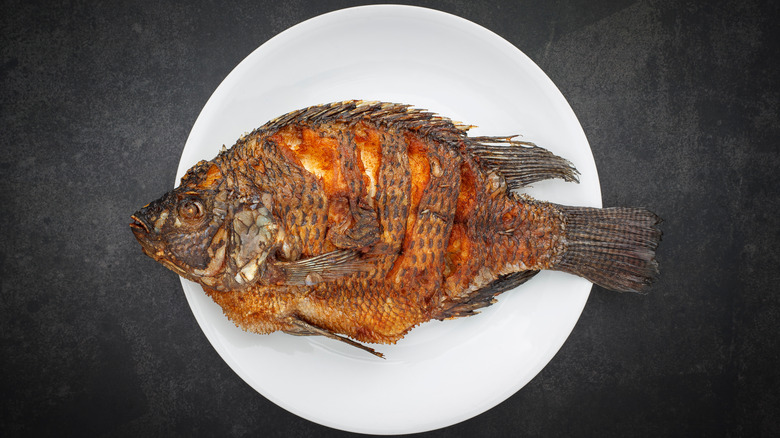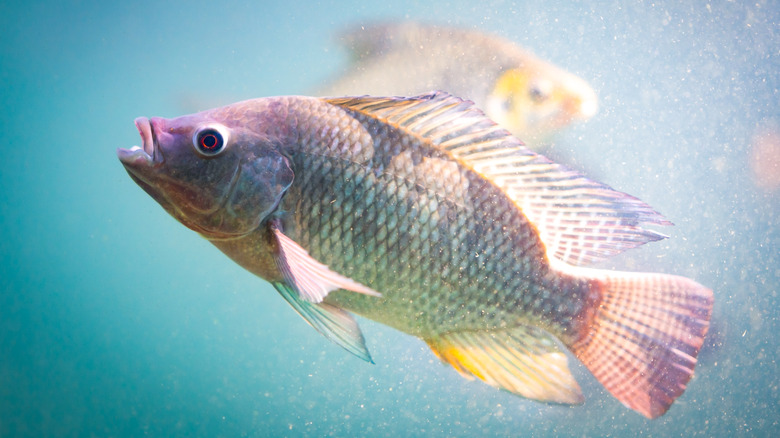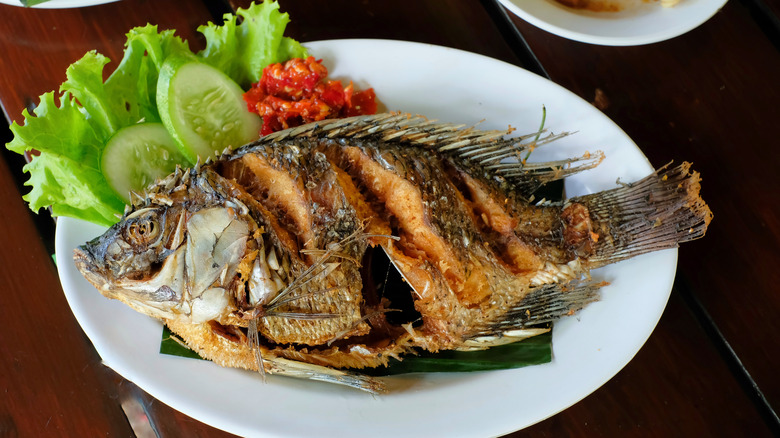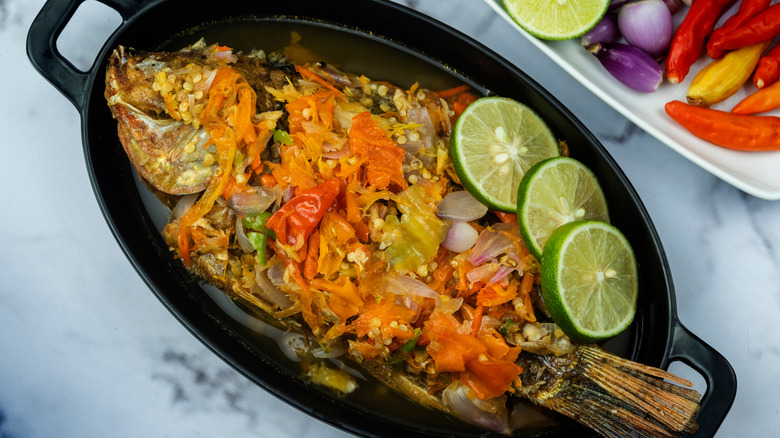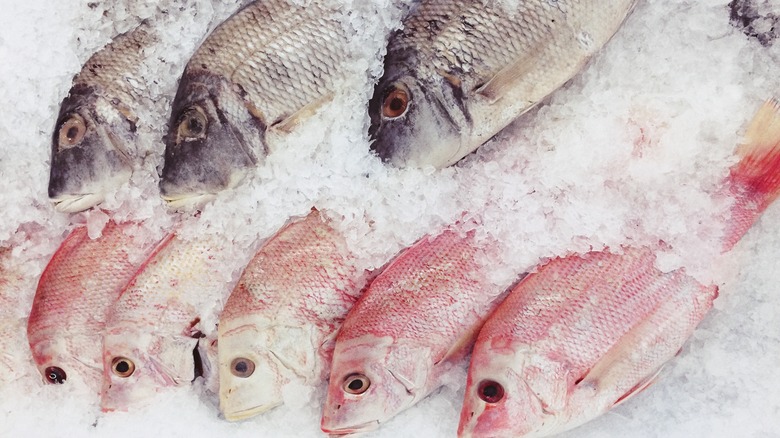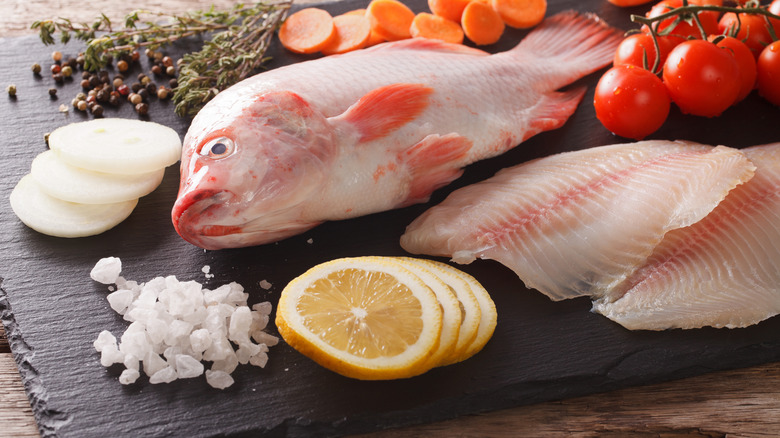What Makes Nile Tilapia Unique
Tilapia is a very popular and delicious fish with a variety of health benefits, with Everyday Health stating that it ranks as the fourth most commonly eaten fish in the United States. It's used in humble home-cooked dinners and fine dining meals alike and is versatile for a variety of cuisines.
Tilapia is a freshwater fish with a very low-maintenance diet, making it a very affordable and accessible fish, per Foods Guy. If you don't like fish or seafood flavors, but enjoy the nutritional benefits or the texture of fish, tilapia's mild flavor and adaptability will likely appeal to you. There are more than 100 reported varieties of tilapia, but the most popular and common of them all is Nile tilapia. As the species name suggests, Nile tilapia are found natively in northern Africa, as well as to the east in the Iberian Peninsula — though it's farmed throughout the world.
What is Nile tilapia?
Nile tilapia is the most common and readily available species of tilapia, with blue tilapia and Mozambique tilapia being the second and third most popular, according to Foods Guy. The fish has been eaten since ancient Egypt, roughly 4,000 years ago (via The Healthy Fish). While it's still native to northern Africa, tilapia is farmed fresh in plenty of countries, including Mexico and Honduras at a rate of 70%, and farmed, frozen, and exported from places like Mexico and Indonesia.
Nile tilapia can be identified by its brown and slightly gray colors, as well as the black bands running down the length of the body, the fins, and vertically down their tails, per Florida Museum. At most, they'll get to be 9.5 pounds in weight, and 23.5 inches in length. They're freshwater fish and can be farmed in waters averaging 80 degrees Fahrenheit.
How are Nile tilapia caught?
Commercially available Nile tilapia is almost always sourced and caught from fish farms rather than the wild, according to The Healthy Fish. Most tilapia, especially Nile tilapia, is raised in Honduras, Mexico, and Indonesia. Health and farm regulation standards vary by country, so Nile tilapia either from the United States or with a specific Aquaculture Stewardship Council certificate is ideal.
Farmed fish helps with ensuring the Nile tilapia are raised in safe, sustainable, and clean conditions, and fed well, resulting in sustainably sourced and delicious fish. All the potential advantages of fish farms have opposite potential disadvantages, too — crowded conditions, improper feeding, dirty water, etc. (via Britannica). If you want to catch your own wild tilapia, you can do so in Florida, Alabama, or Texas where the freshwater ponds, rivers, canals, and lakes are warm enough to sustain their breeding and life cycles, per Take Me Fishing.
What does Nile tilapia taste like?
Nile tilapia is an incredibly adaptable and versatile fish and protein. Compared to other popular fish like salmon, Nile tilapia is very mild and subtle in terms of fishiness, according to The Rusty Spoon. In fact, some Nile tilapia, especially lower quality, may not have much flavor at all. Bear in mind that very low-quality tilapia may have a foul flavor, as it absorbs the flavors of its environment. Chef's Resources warns that tilapia caught in bad water will have a very grassy, muddy taste.
Due to its relatively neutral flavor, there are endless ways to prepare and cook Nile tilapia. It's similar to chicken in that it takes on the taste of its seasonings, so it can easily be incorporated into any number of cuisines. In fact, all tilapia is nicknamed aqua-chicken, per Everyday Health, because of its similar versatility to chicken in terms of cooking, as well as being able to be raised in large quantities.
How to cook with Nile tilapia
Nile tilapia doesn't just have a versatile flavor profile, but it has cooking versatility as well. As The Healthy Fish explains, there is no shortage of ways to cook the freshwater fish, and every method will help imbue it with flavor. The simplest involve baking, grilling, or pan-searing it, but it can also be smoked, steamed, crusted with cheese, braised, stir-fried, and even cured.
The Rusty Spoon also notes that Nile tilapia is a great fish for frying, both pan and deep frying, and is particularly great for fish and chips. You can season Nile tilapia with pretty much anything, but some great spice pairings include garlic, black pepper, paprika, thyme, cayenne, and dill. If you're pan frying or searing Nile tilapia, Precision Nutrition says it's done once the fish flakes with a fork. They also recommend topping fresh cooked Nile tilapia with some freshly squeezed lemon juice and parsley or cilantro.
Where to buy Nile tilapia
Nile tilapia is the most popular and readily available tilapia, and you don't need to go out of your way to purchase it. As The Healthy Fish notes, almost any major grocery store in the United States will have some kind of Nile tilapia, whether fresh or frozen. For fresh Nile tilapia, check the seafood counter at your local supermarket, or go to a fish or seafood market. For frozen Nile tilapia, check the frozen meats aisle.
Whether fresh or frozen, there are a few things you should check before purchasing your tilapia. For example, you should check the country it came from, as well as the producer or hatcher — The Healthy Fish recommends sellers from the United States or Canada for the highest quality Nile tilapia, but Honduras, Mexico, and Indonesia are also good, as is the company Regal Springs.
Certifications are also something to check for. Since tilapia takes in the flavor of its environment, not only do you want an environmental certification for food grade and sustainability but to ensure the fish tastes good. The Aquaculture Stewardship Council, Global Aquaculture Alliance, and Ocean Wise are all good organizations to look for on your Nile tilapia's packaging.
Nutritional information about Nile tilapia
Not only is Nile tilapia delicious, accessible, and incredibly affordable, but it's also a very healthy protein. Healthline counts one serving of tilapia as 3.5 ounces, or 100 grams. Within this 100 grams, tilapia has 26 grams of protein, 3 grams of fat, and 128 calories. It also contains vitamin B12, phosphorus, niacin, selenium, and potassium — all incredibly nutritional and important vitamins and minerals.
However, those looking for healthy fats may choose to look elsewhere for their meal.
People often love fish for the high amounts of Omega-3 fatty acids found within the fat content, but Nile tilapia has a lower healthy fat content than other fish. Unfortunately, Nile tilapia only contains 240 milligrams of Omega-3 fatty acids, but it has lots of Omega-6 fatty acids. Not only is Omega-6 not as nutritional as Omega-3, but it's linked to higher rates of inflammation. It's recommended that those with heart diseases and other inflammatory diseases avoid foods high in Omega-6 fatty acids.
